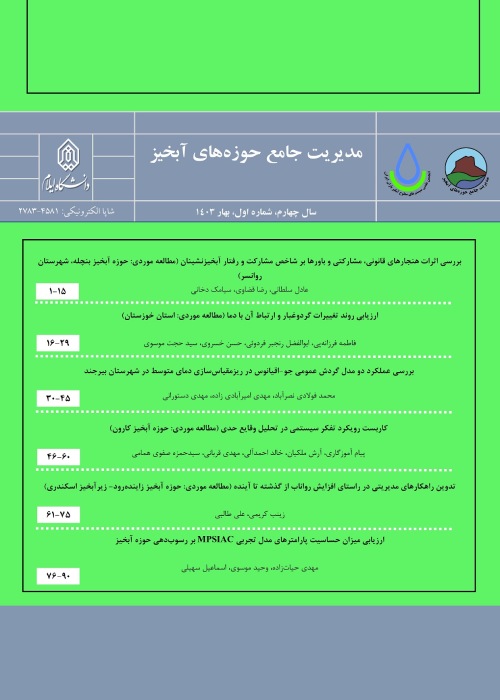Investigating the impact of climatic drought changes on vegetation indicators (Case study: Eshtehard city, Alborz province)
Vegetation provides valuable ecosystem services to various terrestrial ecosystems, such as carbon sequestration, fodder supply, and water resource regulation. It is predicted that the fluctuation and changes of climate in the future will have a great impact on terrestrial ecosystems, including the destruction of rangelands and desertification, increased drying of trees and reduction of carbon sequestration. Drought is a complex and climatic phenomenon that occurs frequently or intermittently in any type of climate and its progress is slow, so that its effects may appear gradually. Due to the high sensitivity of vegetation to climate fluctuations especially in arid and semi-arid regions, droughts can affect vegetation faster and disrupt its natural growth. Therefore, knowing the severity, duration and place covered by the drought phenomenon could reduce the damages. As the global air temperature is continuously increasing under the influence of climate change, the spatio-temporal pattern of rainfall and land use is expected to change significantly in the coming decades. Therefore, it is necessary to develop more accurate and effective drought monitoring tools. In this case, remote sensing plays an important role in drought studies since it ptovides unique data from the earth's surface. Satellite data provide the possibility to identify the damaged vegetation in different types of uses and assess the severity of the damage. Using satellite data to monitor plant activities in a large area has many advantages compared to studies based on traditional methods and is currently a hot topic of pioneering research in the field of drought diagnosis. The purpose of this research is to evaluate the dynamics of vegetation cover and the effect of climate change on it in Eshtehard Karaj township. It is hoped that its results will be used by managers and planners of natural resources for sustainable management of vegetation.
This research was done in two parts. In the first part, the effect of drought on vegetation was investigated using Standardised Precipitation Evapotranspiration Index (SPEI) and Enhanced vegetation index (EVI) , and in the next part, the vulnerability of vegetation was calculated using EVI index. In the second part, SPEI of 3, 6, 9 and 12 months were calculated in MATLAB software for 8 meteorological stations. It should be noted that SPEI has positive and negative values, in which the more negative values indicate the severity of drought. After calculating the SPEI index in the scale of 3, 6, 9 and 12 months for all 8 weather stations, drought intensity maps were obtained using the Inverse Distance Weighted (IDW) method. Then, the ready-made EVI, the MOD13Q1 product of the MODIS sensor was used from the beginning of 2001 to the end of 2022. First, the average EVI index for the entire county of Eshtehard was extracted on a monthly basis and the month with the highest average EVI was selected as the target month. Pearson correlation and coefficient of determination (R2) were calculated between SPEI maps of 3, 6, 9 and 12 months and EVI of the selected month in Earth Trend Modeler (ETM) TerrSet software. Then the time scale of SPEI with the highest R2 was extracted. In the following, the intensity of EVI changes of the selected month was calculated in terms of SPEI changes (slope of changes) using linear analysis in ETM tool of TerrSet software. In the second part, the probability of vegetation vulnerability was calculated using the probability of vegetation vulnerability index (PVVI). For this reason, vegetation condition index (VCI) was first calculated using EVI index. After calculating the VCI index for the selected month of each year in the period from 2001 to 2022, this index was classified into five classes. Then the probability percentage of each class was calculated. Finally, the PVVI index was calculated by multiplying the weight of each class by the probability of its occurrence.
The monthly average EVI index showed that the months of April and October have the highest and lowest average value of EVI in the studied area, respectively. The month of April was chosen as the target month. According to the R2, the relationship between SPEI in different time scales and EVI of the chosen month, in 68.9% of the studied area, three-month SPEI has the strongest relationship with vegetation compared to 6, 9, 12-month SPEI. Most of the mountainous areas in the south of Eshtehard city are in this class. Also, parts of the northwest are included in this class. SPEI of six months in 17.3% of the study area has the strongest relationship with vegetation and SPEI ratio in other time scales. Examining the results of this section showed that the general spatial pattern of vegetation vulnerability probability obtained from the probability of vegetation vulnerability index (PVVI) is to an acceptable extent similar to the pattern of the intensity map of vegetation changes compared to drought. Therefore, the middle belt from west to east is in the probability of vegetation vulnerability map in the high and very high vulnerability class (26.4% and 14.4% of the study area, respectively). In general, 13% and 20.6% of the studied area are placed in the classes of low and very low probability of vulnerability, respectively. These areas are mostly concentrated in the northern belt from east to west, as well as south and southwest of the studied area.
The results of evaluating the probability of vegetation vulnerability in Eshtehard city showed that the general spatial pattern of the probability of vegetation vulnerability obtained from the PVVI index is to an acceptable extent similar to the pattern of the map of intensity of changes in vegetation compared to drought. Therefore, it can be said that the PVVI index can determine areas with high vulnerability of vegetation for better drought management.
- حق عضویت دریافتی صرف حمایت از نشریات عضو و نگهداری، تکمیل و توسعه مگیران میشود.
- پرداخت حق اشتراک و دانلود مقالات اجازه بازنشر آن در سایر رسانههای چاپی و دیجیتال را به کاربر نمیدهد.



